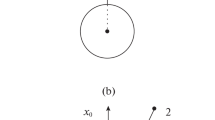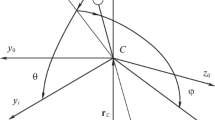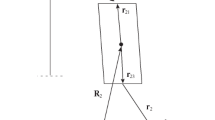Abstract
This paper considers four satellites connected to each other by electrodynamic tethers, which are assumed to be rigid in the mathematical model of the system’s motion. In the Earth’s magnetic field, current-carrying conductors are affected by Lorentz forces, which are used to control the motion of the system’s center of mass and the angular motion. The paper presents an algorithm for calculating the magnitude of the current to stop the drift of the center of mass of a tetrahedral formation relative to the desired orbital reference frame in low Earth orbit and spin the system up to a constant angular velocity relative to the center of mass. A numerical study of the convergence time to achieve the required motion is carried out depending on the maximum possible current and initial conditions.












Similar content being viewed by others
REFERENCES
Shirobokov, M.G. and Trofimov, S.P., Adaptive neural formation-keeping control for satellites in a low-earth orbit, Cosmic Res., 2021, vol. 59, no. 6, pp. 501–516. https://doi.org/10.1134/S0010952521060113
Leonard, C.L., Formation keeping of spacecraft via differential drag, Master Thesis, Massachusetts Inst. Technol., 1986. http://hdl.handle.net/1721.1/13358.
Mashtakov, Y., Ovchinnikov, M., Petrova, T., et al., Two-satellite formation flying control by cell-structured solar sail, Acta Astronaut., 2020, vol. 170, pp. 592–600. https://doi.org/10.1016/j.actaastro.2020.02.024
Ivanov, D., Gondar, R., Monakhova, U., et al., Electromagnetic uncoordinated control of a ChipSats swarm using magnetorquers, Acta Astronaut., 2022, vol. 192, pp. 15–29. https://doi.org/10.1016/j.actaastro.2021.12.014
Shestakov, S., Ivanov, D., and Ovchinnikov, M., Formation-flying momentum exchange control by separate mass, J. Guid. Control. Dyn., 2015, vol. 38, no. 8, pp. 1–10. https://doi.org/10.2514/1.G001137
Peck, M.A., Streetman, B., Saaj, C.M., and Lappas, V., Spacecraft formation flying using Lorentz forces, J. Br. Interplanet. Soc., 2007, vol. 60, no. 7, pp. 263–267.
Peck, M.A., Prospects and challenges for Lorentz-augmented orbits, Collect. Tech. Papers, AIAA Guid. Navig. Control Conf., 2005, vol. 3, pp. 1631–1646. https://doi.org/10.2514/6.2005-5995
Schaffer, L. and Burns, J.A., Charged dust in planetary magnetospheres: Hamiltonian dynamics and numerical simulations for highly charged grains, J. Geophys. Res. SP. Phys., 1994, vol. 99, no. A9, pp. 17211–17223. https://doi.org/10.1029/94JA01231
Saaj, C.M., Lappas, V., Richie, D., et al., Electrostatic forces for satellite swarm navigation and reconfiguration, Final Report for Ariadna Study Id. AO 4919 05, ESA, 2006.
Liu, J., Gangqiang, L., Zhu, Z.H., et al., Automatic orbital maneuver for mega-constellations maintenance with electrodynamic tethers, Aerosp. Sci. Technol., 2020, vol. 105, p. 105910. https://doi.org/10.1016/j.ast.2020.105910
Yang, Y.-W. and Cai, H., Extended time-delay autosynchronization method for libration control of electrodynamic tether using Lorentz force, Acta Astronaut., 2019, vol. 159, pp. 179–188. https://doi.org/10.1016/j.actaastro.2019.03.038
Lu, H., Li, A., Wang, C., and Zabolotnov, Y., Stability analysis and motion control of spinning electrodynamic tether system during transition into spin, Acta Astronaut., 2019, vol. 177, pp. 871–881. https://doi.org/10.1016/j.actaastro.2019.11.032
Voevodin, P.S. and Zabolotnov, Y.M., Analysis of the dynamics and choice of parameters of an electrodynamic space tether system in the thrust generation mode, Cosmic Res., 2020, vol. 58, no. 1, pp. 42–52. https://doi.org/10.1134/S0010952520010062
Ohkawa, Y., Kawamoto, S., Okumura, T., et al., Review of KITE—electrodynamic tether experiment on the H-II transfer vehicle, Acta Astronaut., 2019, vol. 177, pp. 750–758. https://doi.org/10.1016/j.actaastro.2020.03.014
Kalenova, V.I. and Morozov, V.M., Stabilization of satellite relative equilibrium using magnetic and Lorentzian moments, Cosmic Res., 2021, vol. 59, no. 5, pp. 343–356. https://doi.org/10.1134/S0010952521050051
Alexandrov, A.Y. and Tikhonov, A.A., Electrodynamic control with distributed delay for AES stabilization in an equatorial orbit, Cosmic Res., 2022, vol. 60, no. 5, pp. 366–374. https://doi.org/10.1134/S0010952522040013
Kalenova, V.I. and Morozov, V.M., Novel approach to attitude stabilization of satellite using geomagnetic Lorentz forces, Aerosp. Sci. Technol., 2020, vol. 106, no. 1, p. 106105. https://doi.org/10.1016/j.ast.2020.106105
Guzmán, J.J. and Edery, A., Mission design for the mms tetrahedron formation, IEEE Aerosp. Conf. Proc., 2004, vol. 1, pp. 533–540. https://doi.org/10.1109/AERO.2004.1367637
Shestakov, S., Ovchinnikov, M., and Mashtakov, Y., Analytical approach to construction of tetrahedral satellite formation, J. Guid. Control. Dyn., 2019, vol. 42, no. 12, pp. 2600–2614. https://doi.org/10.2514/1.G003913
Guerman, A.D., Smirnov, G.V., Paglione, P., and Seabra, A.M.V., Stationary configurations of a tetrahedral tethered satellite formation, J. Guid. Control. Dyn., 2008, vol. 31, no. 2, pp. 424–428. https://doi.org/10.2514/1.31979
Hill, G.W., Researches in the lunar theory, Am. J. Math., 1878, vol. 1, pp. 5–26.
Ivanov, D., Monakhova, U., and Ovchinnikov, M., Nanosatellites swarm deployment using decentralized differential drag-based control with communicational constraints, Acta Astronaut., 2019, vol. 159, pp. 646–657. https://doi.org/10.1016/j.actaastro.2019.02.006
Mashtakov, Y.V., Ovchinnikov, M.Y., and Tkachev, S.S., Study of the disturbances effect on small satellite route tracking accuracy, Acta Astronaut., 2016, vol. 129, pp. 22–31. https://doi.org/10.1016/j.actaastro.2016.08.028
Barbashin, E.A., Vvedenie v teoriyu ustoichivosti (Introduction to Stability Theory), Moscow: Nauka, 1967.
Künzi, H.P. and Krelle, W., Nichtlineare Programmierung, Berlin: Springer, 1962.
Author information
Authors and Affiliations
Corresponding author
Additional information
Translated by M. Chubarova
Rights and permissions
About this article
Cite this article
Chernov, K.S., Ivanov, D.S. A Study of the Motion of Four Linked Satellites Controlled Using Lorentz Forces. Cosmic Res 61, 339–351 (2023). https://doi.org/10.1134/S0010952523700296
Received:
Revised:
Accepted:
Published:
Issue Date:
DOI: https://doi.org/10.1134/S0010952523700296




